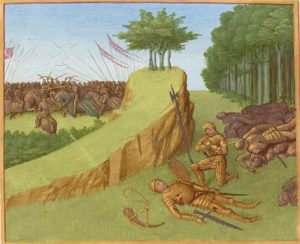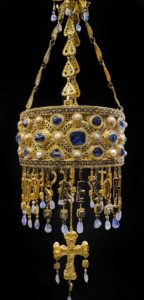The weakening of the Western Roman Empire’s jurisdiction in Hispania began in 409, when the Germanic Suebi and Vandals, together with the Sarmatian Alans entered the peninsula at the invitation of a Roman usurper. These tribes had crossed the Rhine in early 407 and ravaged Gaul. The Suebi established a kingdom in what is today modern Galicia and northern Portugal whereas the Vandals established themselves in southern Spain by 420 before crossing over to North Africa in 429 and taking Carthage in 439. As the western empire disintegrated, the social and economic base became greatly simplified: but even in modified form, the successor regimes maintained many of the institutions and laws of the late empire, including Christianity and assimilation to the evolving Roman culture.

The Byzantines established an occidental province, Spania, in the south, with the intention of reviving Roman rule throughout Iberia. Eventually, however, Hispania was reunited under Visigothic rule. These Visigoths, or Western Goths, after sacking Rome under the leadership of Alaric (410), turned towards the Iberian Peninsula, with Athaulf for their leader, and occupied the northeastern portion. Wallia extended his rule over most of the peninsula, keeping the Suebians shut up in Galicia. Theodoric I took part, with the Romans and Franks, in the Battle of the Catalaunian Plains, where Attila was routed.

Euric (466), who put an end to the last remnants of Roman power in the peninsula, may be considered the first monarch of Spain, though the Suebians still maintained their independence in Galicia. Euric was also the first king to give written laws to the Visigoths. In the following reigns the Catholic kings of France assumed the role of protectors of the Hispano-Roman Catholics against the Arianism of the Visigoths, and in the wars which ensued Alaric II and Amalaric lost their lives.

Athanagild, having risen against King Agila, called in the Byzantines and, in payment for the succor they gave him, ceded to them the maritime places of the southeast. Liuvigild restored the political unity of the peninsula, subduing the Suebians, but the religious divisions of the country, reaching even the royal family, brought on a civil war. St. Hermengild, the king’s son, putting himself at the head of the Catholics, was defeated and taken prisoner, and suffered martyrdom for rejecting communion with the Arians.
Recared, son of Liuvigild and brother of St. Hermengild, added religious unity to the political unity achieved by his father, accepting the Catholic faith in the Third Council of Toledo (589). The religious unity established by this council was the basis of that fusion of Goths with Hispano-Romans which produced the Spanish nation. Sisebut and Suintila completed the expulsion of the Byzantines from Spain.
Intermarriage between Visigoths and Hispano-Romans was prohibited, though in practice it could not be entirely prevented and was eventually legalised by Liuvigild. The Spanish-Gothic scholars such as Braulio of Zaragoza and Isidore of Seville played an important role in keeping the classical Greek and Roman culture. Isidore was one of the most influential clerics and philosophers in the Middle Ages in Europe, and his theories were also vital to the conversion of the Visigothic Kingdom from an Arian domain to a Catholic one in the Councils of Toledo.
